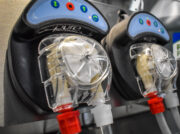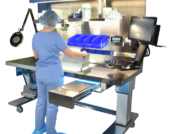
Copper’s Role in Infection Prevention Strategies
Copper has played a significant role in human history, dating back to antiquity. Over the past 11,000 years, copper has become the third most used metal by man, by weight. From ceramics to jewelry to warfare, copper has been used by people for almost every purpose imaginable.
Copper has many unique properties which has allowed its use to flourish1:
- Corrosion-resistant: Copper is commonly used in outdoor, marine, and manufacturing applications due to its ability to withstand moisture, salt, and sulfur.
- Thermal conductivity: Copper allows heat to pass quickly through the metal; consider its popularity in uses like saucepans and boilers!
- Tough & recyclable: Copper can be repurposed because of its highly malleable, ductile properties. Over 80% of the copper mined is still in use today because of its recyclable properties.
- Anti-microbial: Copper has self-sanitizing properties. Our ancestors recognized this when choosing to carry water in copperware, where the water would naturally grow less algae and biofilm.
- Biostatic2: Bacteria and other life forms cannot grow on copper surfaces.
It’s no surprise then that copper is found in our everyday lives; it’s extremely multi-purpose. Where copper’s strength is newly being realized is in our hospital systems.
The Oligodynamic Effect
The Oligodynamic effect3 is a fascinating reaction in science, wherein certain metals have a lethal effect on bacterial cells. Science is still determining how this effect exactly works, but it is believed that metal ions denature the proteins of their target cell membranes by binding to reactive groups, resulting in their inactivation.
Copper is essentially shown to ‘interfere’ with a cell’s normal functions and cause the cell’s rapid death. This reaction is extremely interesting for healthcare applications, where high-touch surfaces come in contact with millions of various pathogens every hour, every day.

Medical Benefits
Because of the denaturing ability of copper, it has been actively studied for use in our hospital systems.
The potential benefits of copper in healthcare settings are far-reaching:
- The anti-microbial properties of copper are intrinsic; it’s an active, continuous process. Human behaviors & processes (washing hands, disinfecting processes, maintaining contact time, etc.) are balanced by copper’s natural, constant ability to denature cells, and thereby dangerous pathogens.
- It’s cost-effective: while some hardware and fixtures need to be custom made, other pre-made copper fixtures, like faucets, drains and door handles, are readily available. The costs associated with switching material are found to be recovered within 2 months. MUSC discovered it could reduce the cost of HAI’s occurring in the patient room by investing in copper patient beds, saving potentially over $200,000 in incurred HAI costs.4
- Installation requires little downtime or training: copper doesn’t need IFU, just polishing and cleaning. It will continue to kill pathogens so long as it’s present on high-touch areas.
- Copper is long-lasting: some copper solutions require replacements, but usually to a lesser degree than non-permanent, consumable anti-microbial solutions.
But Does it Work?
It’s been shown that copper is effective in medical applications: copper has a 99.99% reduction in live bacteria during laboratory testing, and an 83% reduction in bacteria in clinical trials4. That same trial demonstrated a 58% reduction in healthcare associated infection, indicating that hospitals may benefit from evaluating copper-based items to reduce healthcare-associated infection rates, and the costs that come with them.
For more on that study, read our in-depth blog reviewing copper efficacy in clinical settings, here.
Use in Healthcare
Copper has found its way into many hospital applications. You may find it in:

- Faucets: micro-organisms can easily survive in droplets. Copper faucets therefore make great sense for reducing microorganism growth.
- Pipes: some cities and states have mandated the use of copper piping for its anti-bacterial, durable, and thermal properties.
- Patient beds
- IV poles
- Door handles
Copper as a Supplementary Infection Prevention Strategy
Copper is not a replacement for hand washing, regular surface disinfection, instrument reprocessing, and other important infection control practices. It can, however, supplement existing policies and practices that aid in reducing HAI’s. It’s a metal that has proven its worth over centuries of use and testing. Copper’s track record in laboratory and clinical studies also suggest its ability to perform work for us in our hospital systems.
Looking for solutions that integrate copper into instrument reprocessing? Learn about our PureSteel™ Healthcare Reprocessing Sinks to explore the antimicrobial benefit for your department!
Works Cited
- Copper | Uses, Properties, & Facts | Britannica. The Editors of Encyclopaedia Britannica. (2024, March 4). Copper | Uses, Properties, & Facts. Encyclopedia Britannica. https://www.britannica.com/science/copper
- https://pubs.acs.org/doi/10.1021/cm0505244. Copper Nanoparticle/Polymer Composites with Antifungal and Bacteriostatic Properties
- https://www.ncbi.nlm.nih.gov/pmc/articles/PMC6504865/. Streptophyta and Acetic Acid Bacteria Succession Promoted by Brass in Slow Sand Filter System Schmutzdeckes
- A medical breakthrough 4,000 years in the making | MUSC
- https://pubmed.ncbi.nlm.nih.gov/26163568/. From Laboratory Research to a Clinical Trial: Copper Alloy Surfaces Kill Bacteria and Reduce Hospital-Acquired Infections






